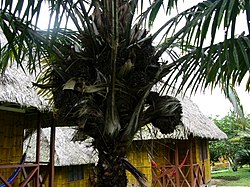Phytelephas
{{{name}}} LATINNAME
|
'
| ||||||||||||||||||||||||||||||||||||||||
|---|---|---|---|---|---|---|---|---|---|---|---|---|---|---|---|---|---|---|---|---|---|---|---|---|---|---|---|---|---|---|---|---|---|---|---|---|---|---|---|---|---|

|
|
| |||||||||||||||||||||||||||||||||||||||
| |||||||||||||||||||||||||||||||||||||||||
| Standard Cyclopedia of Horticulture |
|---|
|
Phytelephas (Greek elephant plant; referring to the hard white seeds which can be worked like ivory). Palmaceae. Low unarmed pinnate palms. Stems stout, erect or prostrate and rooting: lvs. terminal, elongate, pinnatisect; segms. numerous, the upper opposite, the lower alternate or fascicled, linearlanceolate, acuminate, midrib strong: spadices peduncled, scaled, male pendulous, female erect; spathes 2, complete, elongate: fls. dioecious; male minute, perianth lacking, stamens numerous; female very large, sepals 3, petals 5-10, 2-3 in. long, rather fleshy, staminoids many, ovary subglobose: fr. a collection of 4-6 drupes, forming a large cluster. About 15 species, S. Amer. CH
|
Cultivation
- Do you have cultivation info on this plant? Edit this section!
Propagation
- Do you have propagation info on this plant? Edit this section!
Pests and diseases
- Do you have pest and disease info on this plant? Edit this section!
Species
Gallery
If you have a photo of this plant, please upload it! Plus, there may be other photos available for you to add.
-
photo 1
-
photo 2
-
photo 3
References
- Standard Cyclopedia of Horticulture, by L. H. Bailey, MacMillan Co., 1963
External links
- w:Phytelephas. Some of the material on this page may be from Wikipedia, under the Creative Commons license.
- Phytelephas QR Code (Size 50, 100, 200, 500)
